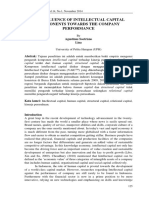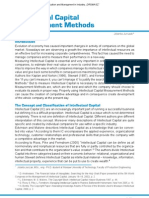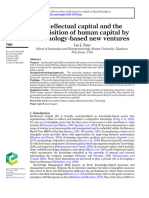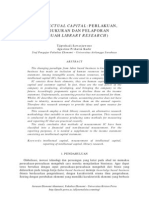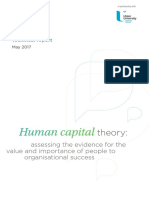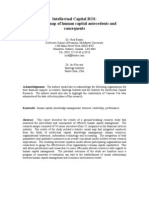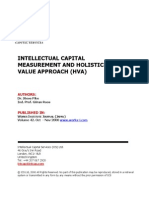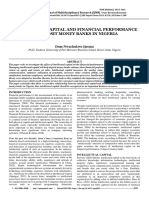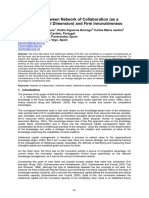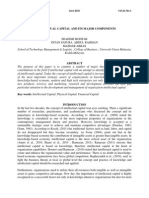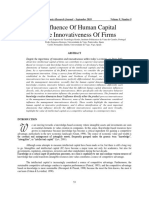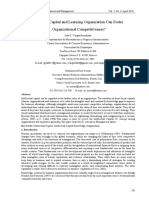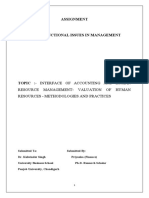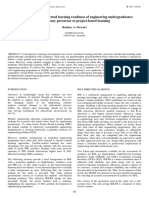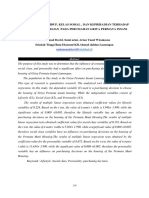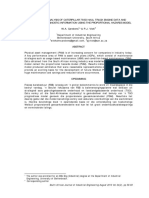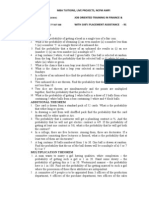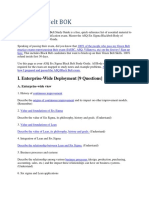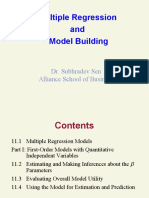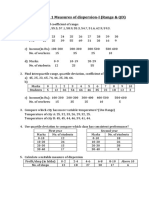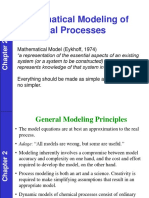Performance Impact of Intellectual Capital: A Study of Indian It Sector
Performance Impact of Intellectual Capital: A Study of Indian It Sector
Uploaded by
Shazia HassanCopyright:
Available Formats
Performance Impact of Intellectual Capital: A Study of Indian It Sector
Performance Impact of Intellectual Capital: A Study of Indian It Sector
Uploaded by
Shazia HassanOriginal Title
Copyright
Available Formats
Share this document
Did you find this document useful?
Is this content inappropriate?
Copyright:
Available Formats
Performance Impact of Intellectual Capital: A Study of Indian It Sector
Performance Impact of Intellectual Capital: A Study of Indian It Sector
Uploaded by
Shazia HassanCopyright:
Available Formats
www.ccsenet.org/ijbm International Journal of Business and Management Vol. 5, No.
9; September 2010
Performance Impact of Intellectual Capital:
A Study of Indian it Sector
Dr. Jyotirmayee Choudhury (Lecturer)
Dept of Business Administration, Utkal University
Vanivihar, Bhubaneswar, Orissa 751004, India
Tel: 91-93380-93142 E-mail: jyotirmayeec@gmail.com
Abstract
Intellectual capital can be defined as the ‘economic value’ of three categories of intangible assets of a
company-that includes human capital, organisational capital and social capital collectively. Sustained advantage
can occur only in the situations in which physical, human, and organisational capital varies across the firms and
where some firms may be unable to obtain necessary resources that are benefiting other firms. Intellectual capital
is viewed as a sub-set of intangible capital, where the term intangible relates to assets without physical existence
and capital refers to assets retained by the organisation to contribute to future profits. Intangible resources are
more likely to produce a competitive advantage because they often are rare and socially complex there by
making them difficult to imitate. A company’s intangible assets are increasingly crucial and positively related to
organisational performance in today’s knowledge economy.
Keywords: Intangible asset, Knowledge economy, Human capital, Organisational capital, Social capital,
Bottom-line
1. INTRODUCTION
Intellectual capital (IC) represents the collective knowledge that is embedded in the personnel, organizational
routines and network relationships of an organization (Stewart, 1997; Bontis & Choo, 2002; Kong, 2008). IC has
been recognized as an important resource that organizations need to develop to gain sustained competitive
advantages (Chen, 2008; Kong & Prior, 2008; Schiuma & Lerro, 2008). Intellectual capital can be defined as the
‘economic value’ of three categories of intangible assets of a company-that includes human capital,
organisational capital and social capital collectively. Strategic analysts argue that sustained advantage can occur
only in the situations in which physical, human, and organisational capital varies across the firms and where
some firms may be unable to obtain necessary resources that are benefiting other firms. Intellectual capital is
viewed as a sub-set of intangible capital, where the term intangible relates to assets without physical existence
and capital refers to assets retained by the organisation to contribute to future profits. Intangible resources are
more likely to produce a competitive advantage because they often are rare and socially complex there by
making them difficult to imitate (Black and Boal, 1994).
Intellectual capital is “firm’s overall or holistic capacity and capability which emerges from its creative and
flexible orchestration and co-ordination of its human capital, innovativeness, competencies and capabilities,
streamlined processes and expertise. Intellectual capital bundles knowledge resources like constellation of
employees, users, processes and technologies and work enabling a company to make a difference to users”.
With the service driven companies in today’s economy out pacing in numbers the manufacturing based
companies, there has been a corresponding shift to include intangible assets on corporate balance sheets and to
incorporate them into market capitalization or valuation and calculation. In addition, since service based
companies rely more on intangible assets than on tangible assets as an indicator of their success; it is logical that
these assets be counted for when reporting financial results to investors. Market leaders such as Charles Schwab
in financial services, Accenture in management consulting Little Mendelson in legal service and even the Walt
Disney Company are where they are because of the knowledge leveraged within each company rather than
because of their tangible assets.
Today, the intangible assets move into the driver’s seat in successful corporations. Forward looking companies
are recognizing the need to measure and manage these assets as carefully as they do their tangible ones. There
are several reasons for this change. First, these companies recognize that human capital drive’s innovation. It is
people not building or machines create new product and service ideas, improve processes, and help companies
shift direction in order to create new sources of value. Whether it is a factory worker, a computer programmer or
72 ISSN 1833-3850 E-ISSN 1833-8119
www.ccsenet.org/ijbm International Journal of Business and Management Vol. 5, No. 9; September 2010
an attorney, the human talent is responsible for inspiring changes. To gain competitive advantage companies
need highly skilled, experienced and motivated people to meet global need. A company’s intangible assets are
increasingly crucial in today’s knowledge economy. In fact, intangible assets are more important to a company’s
survival than are its raw materials. Just as rivers, ports and railroads were the infrastructure of the industrial
revolution; talent and knowledge constitute the infrastructure for growth of economy to-day.
2. OBJECTIVE & METHODOLOGY
The study is intended to open few windows towards intellectual capital management and measurement. Since the
accumulation of intellectual capital is outpacing the accumulation of physical assets as the key driver of
competitiveness in the so called new economy the study is aimed at measuring the extent to which intellectual
capital enhances organisation performance and adds value to the bottom line of the organisation and the
hypotheses for the study is described as follows.
HYPOTHESIS 1: An organisation’s level of human capital is positively related to organisational performance.
HYPOTHESIS 2: An organisation’s level of social capital is positively related to organisational performance.
HYPOTHESIS 3: An organisation’s level of organisational capital is positively related to organisational
performance.
The study is carried out primarily on the basis of field survey. A broad group of IT organisations are included in
the study deliberately. It is because, intellectual capitals constitute the major asset of the IT industry and
simultaneously the sector is also facing enormous challenges maintaining their human resource pool by
attracting the new prospects and retaining the existing one. Although it is the greatest challenge the IT industry is
facing all over the world but the study is confined to some of the Indian IT sector only because of author’s
proximity.
Since the population for the study is heterogeneous, a stratified random technique has been adopted to select the
respondents for the study. 844 respondents were selected randomly from lower middle as well as upper levels
management of the Indian IT organisation out of which 466 responded. A linear regression model was drawn to
explain the relationship between organisation performance and intellectual capital.
Y = β0 + β1Z1+ β2Z2 + . . ..... +βnZn + є
Y ( Y1, Y2, ...... Yn ) are Dependent variables
β0, β1, β2, ........ βn are unknown parameters
Z1, Z2, ............... Zn are independent variables
Є (Є1, Є2, ....... Єn ) are error terms
OP is function of (HC1, HC2, HC3, HC4, HC5)
OP is function of (OC1, OC2, OC3, OC4, OC5)
OP is function of (SC1, SC2, SC3, SC4, SC5)
OP is function of (HC1, HC2, HC3, HC4, HC5), (OC1, OC2, OC3, OC4, OC5), and (SC1, SC2,SC3, SC4, SC5)
Questionnaire-1 consisted 15 items to measure intellectual capital of the concerned organisation in three
different dimensions such as human capital, social capital and organisational capital. Questionnaire-2 designed to
study organisational performance and value of the organisation consisting of 26 items in four different
dimensions like customer service, quality productivity, and innovativeness.
3. PERFORMANCE IMPACT OF INTELLECTUAL CAPITAL
Intellectual capital forms the root of a corporation - and of a Nation - that supplies the nourishment for future
strength and growth. It includes all factors of production, invisible on the traditional balance sheet, but decisive
of a company’s long term profitability. It is a contemporary topic in the business world. Content and message of
intellectual capital has turned traditional accounting upside down. Traditional accounting methods look
backwards into the past and measure physical asset only. Intellectual capital includes assets such as brands,
customer relationships, patents, trademarks and of course knowledge. The growing discrepancy between market
value and book value of a corporation is largely attributed to intellectual capital, the intangibles of business that
underpin future growth.
The importance of people has become increasingly important. HRM is the key factor for increasing employees'
productivity. HR practices turn employees into a resource for development and a source of competitiveness
(Nina Poloski Vokic, Maja Vidovic, 2008.) Money talks, but it does not think. Machines perform, often better
Published by Canadian Center of Science and Education 73
www.ccsenet.org/ijbm International Journal of Business and Management Vol. 5, No. 9; September 2010
than human beings can, but they do not invent. Thinking and invention is the assets upon which knowledge work
and knowledge companies depend (Stewart, 1997). There is no longer just a physical employee rather there is
knowledge employee. The work is less mechanics and more thinking oriented. As Quinn says, “ideas and
intellect, not physical assets built great companies” (Quinn, 1992).
If we are to designate the past as “the old economy” and the present and future as the “new economy”, the old
economy stands for material and the new economy stands for ‘knowledge and creativity’. Intellectual capital are
receiving increased interest both from academic community and companies because of the influence of
innovation and learning on the achievement of competitive advantage for the firm in the new economy. The rise
of the “new economy” one primarily driven by information and knowledge, international competitiveness and
changing patterns of interpersonal activities is attributed to the increased prominence of intellectual capital
management as a management and research topic.
We are living in a knowledge boom, where the common paradigm is that people are the most important asset for
the company. As a result, efforts have been focused on hiring and retaining people with best intellectual abilities
to do the job. Charismatic people always contribute with new ideas, innovations to improve business process and
procedure. Nothing better exemplifies the revolutionary transformation from industrial age thinking to
information age thinking than the new management philosophy of how employees contribute to the organisation
(Kaplan and Norton, 1996). It's referred by Kerry Bunker that there should be a move "to develop more healthy
learning environments and creating more effective learning individuals." If employers can truly create
environment where bright, creative, secure people can learn on their own and land on their feet no matter what
happens to them, Bunker says, then "people would feel a lot less threatened and a lot more resilient. But that
doesn't happen by magic." Intellectual capital is rapidly becoming a very important measure of the company’s
future performance. It is therefore vital that indicators and measures are developed to allow managers to handle
this variable better. It tries to assess the intangible difference between market value and book value of publicly
listed companies. It is a very new topic and therefore theories behind it are very recent.
Management theory has gradually accepted that ‘hidden assets’, which includes both knowledge of employees,
as well as customer and supplier relations, brand loyalty, market position and knowledge that increasingly play
a major role for survival of more companies. Intellectual capital is becoming the most valuable asset of a
company and can be its sharpest competitive weapon. The challenge is “to find, what you have and use it”, wrote
Thomas Stewart (1991).
According to Thomas Stewart (1991), in his article ‘brain power’ intellectual capital is the sum of everything
everybody in your company knows that gives you a competitive edge in the market place. Stewart makes
intellectual capital as attributes of an organisation, and describes intellectual capital as the dynamics effect of
individual’s intellect. These assets are hidden because they do not show up on the balance sheet of companies.
At the same time, as business journals and magazines demonstrate daily, many senior executives realise that
successful companies will be those who do the best job of capturing, nurturing and leveraging employees
knowledge. Skandia, a Swedish financial group has pioneered intellectual capital reporting. It has been rightly
said, “Intellectual capital is the possession of the knowledge, applied experience, organisational technology,
customer relationship and professional skills that provide Skandia with a competitive edge in the market”.
It is rightly said by (Drucker; 1993, Savage; 1996), “we are currently transitioning from industrial era to a
knowledge era, where the traditional factors of production of land, labour and capital are being replaced by the
creation of value through knowledge”. It is individuals, not the company, that own and control the chief source
of competitive advantage that is the knowledge of organizational members. As Peter Ducker has said, in the
knowledge era, the company needs to serve and nurture the “knowledge worker” but at the same time, the
knowledge worker needs the value creative processes and infrastructures of the organisation, as well as
conversation with other knowledge workers to unleash and leverage their knowledge. Both Skandia and Ernst &
Young emphasises the static properties of knowledge that is inventions, ideas, computer programs, patents, etc as
intellectual capital.
Skandia has taken the approach of telling the world about its internal value driver to show the wealth of its
intellectual capital and how it drives organisation’s performance. That’s why concepts like hidden assets,
intangible resources, or most recently, “intellectual capital” often says more about the future earning capabilities
of a company than any of the conventional performance measures we currently use. If the top - fifty
programmers suddenly left Microsoft, the share price of the company is likely to drop drastically. The absurdity
is because of intellectual bankruptcy. As a result of which, the short term profit may very well rise because of
74 ISSN 1833-3850 E-ISSN 1833-8119
www.ccsenet.org/ijbm International Journal of Business and Management Vol. 5, No. 9; September 2010
cost reduction but in long run, it will have negative impact on its financial measures. So the need of the hour is to
better visualise and even measure the growth or decline of intellectual capital (intellectual performance).
Edit Penrose in 1950s, has suggested that competitive advantage did not arise only via various product market
combinations in a given industry, on the contrary, it is mostly due to difference in organizational resources of
different kinds. It is because resources cannot always be transferred or imitated. She has pointed out the
importance of experience and knowledge accumulated within the firm making the firm different from others. We
must look inside the firm to find the real sources for sustainable differences in the resources. Laurence Prusak,
Ernst and Young (Klein and Prusak, 1994) characterises intellectual capital as the ‘intellectual material that has
been formalised, captured and leveraged to produce high valued asset’.
Literature on intellectual capital suggests that, competitive advantage flows from the creation, ownership,
protection, storage and use of certain knowledge based organisational resources. Superior organisational
performance depends on firm’s ability to be good at innovation, learning, protecting, deploying, amplifying and
measuring these strategic intangible resources.
Building on the balance scorecard approach, Skandia, pioneered in developing and implementing a systematic
way of visualizing and measuring intellectual capital. It has come to view, intellectual capital as both what is in
the heads of the employees (human capital) and what is left in the organisation when people go home in the
evening (structural capital). The initiative of Skandia has been followed by other companies including Dow-
chemicals, CIBC, Hewlett- Packard, and Canon.
Firms have increasingly recognised the potential for their people to be a source of competitive advantage (Pfeffer,
1994). Organisations accredit their “capability differential” essentially to their intangible resources. Varied
literatures and perspectives (Human Capital Theory, Organisation Learning, Information processing theory, and
Resource Based Theory) suggest intellectual capital can create value and enhance organisational performance by
lowering costs, increasing customer benefits, or doing some combination of the two. Hence a study By
Khandekar and Sharma (2005), indicates the focus on intellectual capital is a means of both maintaining
competitive advantage and improving the odds of survival in today’s business world.
4. ANALYIS & RESULT
The data for the study were collected from 466 respondents from various IT organisations. The data set covers
various aspects of intellectual capital and organisation performance. As per the table-1 demographic profiles of
the respondents consist of small, medium, and large organisation, where respondents from large organisation
constitute almost half of the total population in the study. Female participants in the study was one third where as
male participants consisted of two third of the total population. Age wise distribution depicts 26-34 age group
dominates in the study consisting of more than 50% of the total sample. The respondents having 5-10 years of
experience at current organisation is very well present in the study consisting of 51% of the total sample.
As defined in table-2 the linear regression equation customer satisfaction with human capital and social capital
depicts that the model is well fit with adjusted R² all close to 0.7. The model does not explain the fit between
customer satisfaction and social capital of the organisation with R² value 0.373. All the parameters of intellectual
capital in combination drives customer satisfaction component of organisation performance with R² value 0.785
corroborating all the hypotheses under study i. e, intellectual capital drives organisational performance.
The regression equation of the service quality component with human capital, and organisational capital shows
both the component of intellectual capital influences significantly product or service quality with R² value close
to 0.7. The effect social capital on service quality is not significant with R² value 0.279 but intellectual capital as
a whole has strong influence on service quality with R² value 0.709.
The regression equation of productivity component with human capital, and organisational capital clearly depict
the model is poorly fit with R² less than 0.45. Social capital is weak in explaining the relationship with R² value
0.12.
The regression equation of organisational innovation with human capital, and organisational capital clearly
depict the model is well fit with R² above 0.6. Only social capital is weakly explaining the model with R² value
0.272 but intellectual capital as a whole drives innovation with R² value 0.727.
5. DISCUSSION
The present study found that each of the three types of intellectual capital to be associated with increased
organisational performance. Human capital exhibited strong relationship with performance lending support to the
widespread anecdotal evidence suggesting that talented people are critical ingredient in developing and
Published by Canadian Center of Science and Education 75
www.ccsenet.org/ijbm International Journal of Business and Management Vol. 5, No. 9; September 2010
delivering superior products and services that generate high consumer demand. Scholars and practitioners have
argued for quite some time that many of the fastest growing companies over the past several decades ( Southwest
Airlines, Tyson Foods, Wal-Mart) achieved their phenomenal growth and competitive advantage through their
talented people (Pfeffer, 1994). Hence the elements of human capital management are central to the successful
implementation of most other management initiatives and achieving the firm's strategic goal (Verreault and
Hyland 2005).
Social capital is regarded as the strongest predicator of performance (Adler and Kwon, 2002; Kostova and Roth,
2003). Such a strong linkage between social capital supports that knowledge tied up in relationship among
employees, customers, suppliers, alliance partners, and the like tends to lead to process and product innovations,
better problem solving which tends to increase production and service delivery efficiencies as well as customer
satisfaction. Social capital also enable organisations to utilise their knowledge base by leveraging it across the
entire organisation and thereby reduce redundancies, effort duplication and ultimately organisational costs but
the study found social capital is poorly related with all the components of intellectual capital. So collaborative
management and consensual decision making is in preaching only. It is yet to be recognised and practiced,
The relationship between organisational capital and performance become statistically significant in the study.
Since individuals form the basis of organisational level of learning and knowledge accumulation (Organisational
Capital) and institutionalisation of knowledge and knowledge sharing is highly encouraged in Indian IT sector,
there is strong co-relation between organisational capitals with its bottom line.
6. CONCLUSION
We are living in a knowledge economy. “Knowledge driven economy is one which the generation and
exploitation of knowledge play the predominant part in creation of wealth” (United kingdom department of trade
and industry 1998). People are an organisation’s greatest asset, providing the intellectual capital that drives
differentiation and value-added services. Intellectual capital is considered as the number one business driver in
the organisation since the currency of the knowledge economy is intellectual capital. So there is a growing
need for reporting on intangibles by intellectual capital reports, which complement traditional financial
statements.
Talented people are critical ingredient in developing and delivering superior products and services that generate
high consumer demand. By recognizing, developing, and utilizing capabilities embedded in the collective
knowledge of firm's members, HRD can play a very important role in developing people's capabilities as a
source of sustainable competitive advantage. Therefore organizations are designing their HR systems to enable
employees to use their knowledge for a competitive edge (Khandekar and Shrama 2005a).
Knowledge tied up in relationships among employees, customers, suppliers, alliance partners, and the like tends
to lead to process and product innovations, better problem solving and so on increasing production and service
delivery efficiencies as well as customer satisfaction. Codified and documented knowledge helps in
institutionalisation of knowledge and knowledge sharing for further analysis by knowledge workers.
Therefore intellectual capital does play significant role in determining organisational performance, we need to
better understand how to build, manage and leverage it. Transparency through intellectual capital reporting is not
only demanded by capital markets but also by other firm stakeholders such as employees, customers, suppliers
and in general the society. In conclusion it can be stated that intellectual capital reporting is a highly efficient
communication device and all the recent hype surrounding intellectual capital appears to be warranted. All the
business leaders, researchers; academicians should be appreciative of the power of intellectual capital as an
organisation performance driver. The study of intellectual capital stocks and its exponential growth due to
organisational learning produces tremendous energy, which can take companies far beyond their current vision.
References
Black, J. A, & Boal, K. (1994). Strategic resources: Traits, configurations, and paths to sustainable competitive
advantage. Strategic Management Journal, 15(1), 131-148
Carol Yeh-Yun Lin & Mavis Yi-Ching Chen. (2008). Developing human capital indicators: a three-way
approach - Special Issue on Intellectual Capital in Taiwan. 5 (3/4), 387-403
J. B Quinn. (1992). The intelligent enterprise a new paradigm. Academy of Management Executive, 6(4), 1-48.
Kerry A. Bunker and Michael Wakefield. (2008). The Balance Needed to Lead Change. The Creative
Leadership Forum Asia Pacific & Australia, (September Issue)
76 ISSN 1833-3850 E-ISSN 1833-8119
www.ccsenet.org/ijbm International Journal of Business and Management Vol. 5, No. 9; September 2010
Khandekar, A., & Sharma, A. (2005a). Managing human resource capabilities for sustainable competitive
advantage. Education Training, 47(8/9), 628-639.
Klein, D.A and Prusak, L. (1994). Characterising Intellectual capital - Centre for Business Innovation.
Cambridge, MA, UK, Working paper, March Issue
Kong, E. (2008). The development of strategic management in the non-profit context: intellectual capital in
social service non-profit organizations. International Journal of Management Reviews, 10(3), 281-99.
Kong, E., & Prior, D. (2008). An intellectual capital perspective of competitive advantage in nonprofit
organisations. International Journal of Nonprofit and Voluntary Sector Marketing, Vol. 13 pp.119-28.
Kostova, T., & Roth, K (2003) Social capital in multinational corporations and a micro-macro model of its
formation. Academy of Management Review, 28: 297-317
Lockwood Nancy R., & SPHR, GPHR, M.A. (2006). Maximizing Human Capital: Demonstrating HR Value
With Key Performance Indicators. SHRM Research, 3rd quarter , 1-12
Nina Poloski Vokic & Maja Vidovic. (2008). HRM as a significant factor for achieving competitiveness through
people: the Croatian case. International Advances in Economic Research, 14(3), 303-315
Paul.S.Adler & Seok Woo Kwon. (2002). Social Capital - Prospect for a new concept. Academy of Management
Review, 27(1), 17-40
Robert S. Kaplan and David P. Norton. (1996). Linking the Balance Scorecard to strategy. California
Management Review, 39(1), fall, 1-27
Schiuma G., & Lerro A. (2008). Knowledge-based capital in building regional innovation capacity. Journal of
Knowledge Management, Vol. 12, Issue 5, pp. 121-136
Snell, Scott A. (2004), Human resource configurations, intellectual capital, and organizational performance.
Journal of Managerial Issues, September issue, pp 1-25.
Stewart, Thomas A. (1991). Brainpower: Intellectual Capital Is Becoming Corporate America's Most Valuable
Asset and Can Be Its Sharpest Competitive Weapon, Fortune, Spring issue, 44-57
Verreault, D. A., & Hyland, M. A. (2005). Evidence for increasing the focus on strategic risk in HRM audits.
Managerial Auditing Journal, 20(5), 524-543
Bontis, Nick & Choo, Chun Wei. (2002). The Strategic Management of Intellectual Capital and Organizational
Knowledge. Oxford University Press, New York
Edith Penrose. (1959). The Theory of the Growth of the Firm. Blackwell Publishers, Oxford, UK
Peter F. Drucker. (1993). Innovation and Entrepreneurship, Practice and Principles. Harpercollins Publishers,
New work, NY, USA
Jeffrey Pfeffer. (1994). Competitive Advantage through People: Unleashing the Power of the Workforce.
Harvard Business School Press, MA, USA
Savage, C. (1996). Fifth Generation Management. Butterworth-Heinemann, Boston, MA
Stewart, T. (1997). Intellectual Capital: The New Wealth of Organisations. Doubleday Business, New Work,
USA
Published by Canadian Center of Science and Education 77
www.ccsenet.org/ijbm International Journal of Business and Management Vol. 5, No. 9; September 2010
Appendix-A
Table 1. Respondents Profile
Parameter Group # %
Size Small 143 30.7
Medium 108 23.2
Large 215 46.1
Sex Female 172 36.91
Male 294 63.09
Role Senior Management 106 22.75
Middle Management 132 28.33
Junior Management 142 30.47
Non Management 86 18.45
Age 26- 56 12.02
26-34 246 52.79
34-42 92 19.74
42-50 52 11.16
50+ 20 4.29
Organisation
Experience 2yr- 106 22.75
2 To 5 78 16.74
5 To 10 239 51.29
10 To 20 33 7.08
20- 10 2.14
Total Experience 2yr- 30 6.44
2 To 5 94 20.17
5 To 10 168 36.05
10 To 20 138 29.61
20- 36 7.73
Total 466 100
Appendix-B
Table 2. Organisation Performance Vs Intellectual Capital
Organisation Intellectual Multiple Adjusted Std.
Performance Capital R R2 R2 Error
HC .815(a) 0.665 0.664 0.3123
SC .611(a) 0.373 0.372 0.4271
Customer OC .881(a) 0.776 0.776 0.2551
Satisfaction HC,SC,OC .887(a) 0.786 0.785 0.25
HC .777(a) 0.604 0.603 0.3274
SC .528(a) 0.279 0.277 0.4419
Service/Product OC .838(a) 0.702 0.702 0.2838
Quality HC,SC,OC .843(a) 0.711 0.709 0.2804
HC .647(a) 0.418 0.417 0.4087
SC .349(a) 0.122 0.12 0.502
OC .616(a) 0.379 0.378 0.4221
Productivity HC,SC,OC .655(a) 0.43 0.426 0.4055
Innovations HC .777(a) 0.603 0.602 0.4555
SC .523(a) 0.274 0.272 0.6161
OC .850(a) 0.722 0.721 0.3814
HC,SC,OC .853(a) 0.728 0.727 0.3776
78 ISSN 1833-3850 E-ISSN 1833-8119
www.ccsenet.org/ijbm International Journal of Business and Management Vol. 5, No. 9; September 2010
Appendix- C. Intellectual Capital Questionnaire
Human Capital
1. Our employees are highly skilled and talented
2. Our employees are widely considered one of the best in our industry
3. Our employees are very creative and innovative
4. Our employees have enough knowledge and skill to finish their own job
5. Employees generally use new idea and knowledge to develop a solution
Social Capital
6. Our employees are skilled at collaborating with each other to diagnose and solve problem and
issues.
7. Our employees share information with other and learn from other within their own team and
department
8. Our employees interact and exchange ideas with cross functional department and division.
9. Our employees partner with customers, vendors and other alliance partners to develop solutions.
10. Our employees apply knowledge from one area of the organisation to problem and opportunities
that arises in another part of the organisation.
Organisation Capital
11. Our organisation uses white paper, case studies, patents as a way to store knowledge.
12. Much of our organisation’s knowledge is contained in manuals, and databases.
13. Our organisation has an enterprise information portal having easy access to various information
source.
14. Our organisation’s culture (stories, rituals) contains variable ideas and ways of doing certain
businesses.
15. Our organisation embeds much of its knowledge and information in structures, systems and
processes.
Appendix- D. Organisation Performance Questionnaire
Customer Service
1. Complaints on our products/solutions are negligible
2. Customers are delighted with our service capabilities
3. Our service turnover time is one of the lowest in our industry.
4. We give maximum importance to our customers commitments
5. Our employees understand current and future need of our customer
6. Meet customer expectations and strive to exceed customer expectations
7. Our repeat business is above 90% which is one of the highest in the industry
8. We get a decent percentage of new customers because of positive customer referrals
9. Mutual relationship with customer and supplier is increased over the period
10. Deliver the promises made to customer
Quality
11. Our solutions are very reliable and stable
12. Our solutions are cost effective
13. The defect injection rate is below the industry average
14. We usually prevent repeat mistakes
15. Our acceptance defects density is very low
16. The cost of quality is one of the lowest in the industry
Published by Canadian Center of Science and Education 79
www.ccsenet.org/ijbm International Journal of Business and Management Vol. 5, No. 9; September 2010
Productivity
17. The solution cycle time is reduced drastically over the period.
18. Our productivity is continuously improving over the time.
19. Our in time solution delivery record is one of the best in industry.
20. Our people easily adapts to new platform compare to our counterparts.
21. Organisation’s per person productivity is better than the industry average
22. We share the productivity benefits with our customer which in turn generates repeat business.
Innovations
23. Usage of reusable components increases the productivity drastically.
24. Reusable components increase the product stability and reduce defect injection rates.
25. We use white papers, case studies, project artefacts in our solutions.
26. Our solution design is very robust
Acknowledgement
The author of this article wishes to thank all the IT professionals who kindly participated in this study.
She would also like to express her appreciation to his teacher Prof B B Mishra and husband Mr suresh
Ch Nayak for their expert advice and consistent support.
Author
Dr. (Mrs) Jyotirmayee Choudhury is a Lecturer in Utkal University in the Department of Business
Administration with specialisation in the field of Human Resources Management. She has about seven
years of teaching and research experience. She has visited the USA and Singapore in her study
connection. She has published 8 papers in leading Indian journals.
80 ISSN 1833-3850 E-ISSN 1833-8119
You might also like
- Missing and Modified Data in Nonparametric EstimationDocument465 pagesMissing and Modified Data in Nonparametric EstimationJunhy100% (1)
- 3 1 311 587Document4 pages3 1 311 587JOSHUANo ratings yet
- Anis Case Study of Soft Drink Demand EstimationDocument10 pagesAnis Case Study of Soft Drink Demand EstimationNorhanisah Han75% (4)
- 76-Article Text-76-1-10-20170315Document16 pages76-Article Text-76-1-10-20170315Pedro GonçalvesNo ratings yet
- Intellectual Capital Measurement MethodsDocument9 pagesIntellectual Capital Measurement MethodsLuciana Nagel-PiciorusNo ratings yet
- 10 1108 - Jic 04 2021 0122Document19 pages10 1108 - Jic 04 2021 0122Teguh SetiawanNo ratings yet
- Intellectual Capital and Value Creation-Is Innovation Capital A Missing Link?Document10 pagesIntellectual Capital and Value Creation-Is Innovation Capital A Missing Link?ratiehayoeNo ratings yet
- Intellectual Capital Measurement The Yes and NoDocument6 pagesIntellectual Capital Measurement The Yes and NoarcherselevatorsNo ratings yet
- Influence of Intellectual Capital in The Organizational InnovationDocument8 pagesInfluence of Intellectual Capital in The Organizational InnovationsopingiNo ratings yet
- Working Paper FOB USBI-13-05-Selvi Meliza Salim, and Golrida KaryawatiDocument13 pagesWorking Paper FOB USBI-13-05-Selvi Meliza Salim, and Golrida KaryawatiSyaifuddinNo ratings yet
- Intellectual Capital and Its Major Components 2Document8 pagesIntellectual Capital and Its Major Components 2ouciefnadia1973No ratings yet
- Intellectual CapitalDocument23 pagesIntellectual CapitalchoirunnissaNo ratings yet
- The Impact of Intellectual Capital On Jammu & Kashmir Project Construction Corporation LTD, J&KDocument16 pagesThe Impact of Intellectual Capital On Jammu & Kashmir Project Construction Corporation LTD, J&KTJPRC PublicationsNo ratings yet
- Impact HCMDocument17 pagesImpact HCMAndi Nurlelasari AsNo ratings yet
- The Impact of Intellectual Capital On Organizational PerformanceDocument9 pagesThe Impact of Intellectual Capital On Organizational PerformanceAqsaNo ratings yet
- Intellectual CapitalDocument23 pagesIntellectual CapitalikhwankamalNo ratings yet
- The Impact of Intellectual Capital On Business OrganizationDocument17 pagesThe Impact of Intellectual Capital On Business OrganizationB2MSudarman IfolalaNo ratings yet
- SSRN Id2251620Document15 pagesSSRN Id2251620mohammad.mamdooh9472No ratings yet
- Intellectual Capital and Its Relationship With Universities: SciencedirectDocument5 pagesIntellectual Capital and Its Relationship With Universities: SciencedirectMsuBrainBoxNo ratings yet
- Journal of Business Research: SciencedirectDocument10 pagesJournal of Business Research: SciencedirectMartha Judith Correa VallejoNo ratings yet
- AbstractDocument35 pagesAbstracthuzaifa anwarNo ratings yet
- Human Capital Theory Assessing The EvidenceDocument96 pagesHuman Capital Theory Assessing The EvidencehasanNo ratings yet
- The Impact of Intellectual Capital On Innovation: A Literature StudyDocument13 pagesThe Impact of Intellectual Capital On Innovation: A Literature StudyA.s.qudah QudahNo ratings yet
- Intellectual CapitalDocument6 pagesIntellectual CapitalMuostapha FikryNo ratings yet
- Intellectual Capital & Return On Investment: Case Study: Iranian Stock ExchangeDocument15 pagesIntellectual Capital & Return On Investment: Case Study: Iranian Stock Exchangesaliah85No ratings yet
- Intellectual Capital ROIDocument26 pagesIntellectual Capital ROIElny WidjajaNo ratings yet
- Case03 HRA DEC2013Document33 pagesCase03 HRA DEC2013Richard Rhamil Carganillo Garcia Jr.No ratings yet
- Intellectual CapitalDocument16 pagesIntellectual CapitalArslan AyubNo ratings yet
- Human Capital Is Arguably The Most Valuable Asset Held by An Organization TodayDocument20 pagesHuman Capital Is Arguably The Most Valuable Asset Held by An Organization Todayelikong1114No ratings yet
- ICS Article 2000 IC Measurement HVADocument15 pagesICS Article 2000 IC Measurement HVAmantancakrabyuhaNo ratings yet
- 936pm - 42.epra Journals 13232Document4 pages936pm - 42.epra Journals 13232MUSLIM AKILUNo ratings yet
- Earning Quality ICDocument6 pagesEarning Quality ICnovitaanggrainiNo ratings yet
- Pengaruh Intellectual Capital Terhadap Kinerja Keuangan Dan Nilai Pasar Perusahaan Perbankan Dengan Metode Value Added Intellectual CoefficientDocument0 pagesPengaruh Intellectual Capital Terhadap Kinerja Keuangan Dan Nilai Pasar Perusahaan Perbankan Dengan Metode Value Added Intellectual CoefficientAhmad HakemNo ratings yet
- Effect of Intellectual Capital On Organizational PerformanceDocument8 pagesEffect of Intellectual Capital On Organizational PerformanceAl Moazer Abdulaal AbdulateefNo ratings yet
- A Study On The Effect of Intellectual Capital ...Document17 pagesA Study On The Effect of Intellectual Capital ...Breeze MaringkaNo ratings yet
- Garuda 574159Document20 pagesGaruda 574159Khurun LalaNo ratings yet
- Intellectual Capital and Economic Value Added of Quoted Service Firms in NigeriaDocument10 pagesIntellectual Capital and Economic Value Added of Quoted Service Firms in NigeriaEditor IJTSRDNo ratings yet
- The Relation Between Network of CollaborDocument8 pagesThe Relation Between Network of CollaborAna Paula SantosNo ratings yet
- Effect of Intellectual Capital On The Profitability of Nigerian Deposit Money BanksDocument13 pagesEffect of Intellectual Capital On The Profitability of Nigerian Deposit Money BanksEditor IJTSRDNo ratings yet
- Intellectual CapitalcDocument4 pagesIntellectual CapitalcshuvoertizaNo ratings yet
- Intangible AssetsDocument23 pagesIntangible AssetsDarshan ManjuNo ratings yet
- Intellectual Capital and Its Major ComponentsDocument7 pagesIntellectual Capital and Its Major Componentsmyie83No ratings yet
- The Influence of Human Capital On The inDocument12 pagesThe Influence of Human Capital On The inAna Paula SantosNo ratings yet
- 05-INT-The Link Between Intellectual Capital and Business Performance A Mediation Chain ApproachDocument21 pages05-INT-The Link Between Intellectual Capital and Business Performance A Mediation Chain ApproachSulaiman HanifNo ratings yet
- Intellectual Capital Impact On Investment Recommendations Evidence From IndonesiaDocument11 pagesIntellectual Capital Impact On Investment Recommendations Evidence From IndonesiaAlexander DeckerNo ratings yet
- It's High-Time To Come To Terms With HCM - The Superset of HRM!Document13 pagesIt's High-Time To Come To Terms With HCM - The Superset of HRM!prjpublicationsNo ratings yet
- Intellectual CapitalDocument12 pagesIntellectual Capitaltramo1234100% (4)
- Assignment: Resource Management-Valuation of Human Resources - Methodologies and PracticesDocument11 pagesAssignment: Resource Management-Valuation of Human Resources - Methodologies and PracticespriyankaNo ratings yet
- How Intellectual Capital and Learning Organization Can Foster Organizational Competitiveness?Document11 pagesHow Intellectual Capital and Learning Organization Can Foster Organizational Competitiveness?Samantha De CárdenasNo ratings yet
- The Role of Human Capital InvestmentDocument11 pagesThe Role of Human Capital InvestmentRanaNo ratings yet
- Intellectual Capital EfficiencyDocument7 pagesIntellectual Capital EfficiencyAnonymous 4gOYyVfdfNo ratings yet
- Relationship Between Intellectual Capital and Organizational Agility With Mediatory Role of Employee Empowering in Service Sector (Case Study: Karafarin Insurance Company)Document5 pagesRelationship Between Intellectual Capital and Organizational Agility With Mediatory Role of Employee Empowering in Service Sector (Case Study: Karafarin Insurance Company)TI Journals PublishingNo ratings yet
- Determinants of Enterprise Performance Small Technology-Intensive Enterprises: Intellectual Capital and Innovation Capability TheDocument4 pagesDeterminants of Enterprise Performance Small Technology-Intensive Enterprises: Intellectual Capital and Innovation Capability Themaher76No ratings yet
- HRA in InfosysDocument17 pagesHRA in Infosysअंजनी श्रीवास्तवNo ratings yet
- Assignment: Resource Management-Valuation of Human Resources - Methodologies and PracticesDocument7 pagesAssignment: Resource Management-Valuation of Human Resources - Methodologies and PracticespriyankaNo ratings yet
- Reflections On The Criteria For The Sound Measurement - 2020 - Critical PerspectDocument15 pagesReflections On The Criteria For The Sound Measurement - 2020 - Critical PerspectCosmin GhitaNo ratings yet
- Intellectual Capital and BusinDocument16 pagesIntellectual Capital and BusinEkta MehtaNo ratings yet
- Human Capital Development PDFDocument11 pagesHuman Capital Development PDFAnaya Mehar (anaya)No ratings yet
- Intellectual Capital (Review and Analysis of Edvinsson and Malone's Book)From EverandIntellectual Capital (Review and Analysis of Edvinsson and Malone's Book)Rating: 5 out of 5 stars5/5 (2)
- The Skills-Powered Organization: The Journey to the Next-Generation EnterpriseFrom EverandThe Skills-Powered Organization: The Journey to the Next-Generation EnterpriseNo ratings yet
- Adapting to the Future: Transitioning Workers in the Age of AIFrom EverandAdapting to the Future: Transitioning Workers in the Age of AINo ratings yet
- Why Do Managers Leave Their Organization? Investigating The Role of Ethical Organizational Culture in Managerial TurnoverDocument17 pagesWhy Do Managers Leave Their Organization? Investigating The Role of Ethical Organizational Culture in Managerial TurnoverShazia HassanNo ratings yet
- Evaluating The Self-Directed Learning Readiness of Engineering Undergraduates: A Necessary Precursor To Project-Based LearningDocument4 pagesEvaluating The Self-Directed Learning Readiness of Engineering Undergraduates: A Necessary Precursor To Project-Based LearningShazia HassanNo ratings yet
- Research PaperDocument14 pagesResearch PaperShazia HassanNo ratings yet
- Lets Talk About Self-ConceitDocument16 pagesLets Talk About Self-ConceitShazia HassanNo ratings yet
- InTech-Analytical Method ValidationDocument19 pagesInTech-Analytical Method ValidationIordache SorinNo ratings yet
- Customer Churn Prediction in Telecom Industry: Sourav Sarkar (Group 7)Document30 pagesCustomer Churn Prediction in Telecom Industry: Sourav Sarkar (Group 7)prince2venkat100% (1)
- Pengaruh Gaya Hidup, Kelas Sosial, Dan Kepribadian Terhadap Keputusan Pembelian Pada Perumahan Griya Permata InsaniDocument17 pagesPengaruh Gaya Hidup, Kelas Sosial, Dan Kepribadian Terhadap Keputusan Pembelian Pada Perumahan Griya Permata Insanisri wahyuningsihNo ratings yet
- Exploring Relationships: Allen DowneyDocument38 pagesExploring Relationships: Allen DowneyALEJANDRA NORIEGA TORRESNo ratings yet
- PracticeDocument3 pagesPracticeflathogathNo ratings yet
- Statistical Analysis of Caterpillar 793D Haul Truck Engine DataDocument10 pagesStatistical Analysis of Caterpillar 793D Haul Truck Engine DataSaul Leonidas Astocaza AntonioNo ratings yet
- Appuhami Ranjith BDocument8 pagesAppuhami Ranjith Bnational coursesNo ratings yet
- 20IT503 - Big Data Analytics - Unit3Document78 pages20IT503 - Big Data Analytics - Unit35023-Monish Kumar KNo ratings yet
- SFMProblemsDocument21 pagesSFMProblemsChaitanya MulukutlaNo ratings yet
- Predicting Long TermDocument14 pagesPredicting Long TermJimey BrownNo ratings yet
- Asq Black BookDocument15 pagesAsq Black Bookafreen timberwallaNo ratings yet
- Fair Value Accounting and Corporate Reporting in Nigeria - A LogisticsDocument10 pagesFair Value Accounting and Corporate Reporting in Nigeria - A LogisticsNenk KhawensaNo ratings yet
- Internship Report ON: Customers Satisfaction On Different Departments of Shahjalal Islami Bank LimitedDocument11 pagesInternship Report ON: Customers Satisfaction On Different Departments of Shahjalal Islami Bank LimitedAshraful IslamNo ratings yet
- 2association of Perceived Stress With Stressful Life EventsDocument12 pages2association of Perceived Stress With Stressful Life EventsStefan DincaNo ratings yet
- Nanyang Technological University Entrance Examination Syllabus Maths (A)Document17 pagesNanyang Technological University Entrance Examination Syllabus Maths (A)FaiqNo ratings yet
- Multiple Regression and Model Building: Dr. Subhradev Sen Alliance School of BusinessDocument150 pagesMultiple Regression and Model Building: Dr. Subhradev Sen Alliance School of BusinessDebojit PalNo ratings yet
- Effect of Leadership Styles On The PerfoDocument12 pagesEffect of Leadership Styles On The PerfoNurulhudda ArshadNo ratings yet
- Cronbach's Alpha N of Items: Reliability StatisticsDocument3 pagesCronbach's Alpha N of Items: Reliability StatisticsAnas Romzy HibridaNo ratings yet
- Cayanan-Mbbc 514-8865Document107 pagesCayanan-Mbbc 514-8865Veronica CruzNo ratings yet
- Regression An OvaDocument24 pagesRegression An Ovaatul_sanchetiNo ratings yet
- Trend Surface AnalysisDocument50 pagesTrend Surface Analysisnebil belaidNo ratings yet
- Assignment-XIDocument2 pagesAssignment-XIAbhishek PanditNo ratings yet
- Jurnal Penelitian Pendidikan IPA (JPPIPA)Document16 pagesJurnal Penelitian Pendidikan IPA (JPPIPA)Raden HamidiNo ratings yet
- Stats I Pracs Sem IIDocument14 pagesStats I Pracs Sem IIJayesh DalviNo ratings yet
- Mathematical Modeling of Chemical ProcessesDocument26 pagesMathematical Modeling of Chemical Processesmeseret sisayNo ratings yet
- Measurement Technologies: by Hassanain Ghani HameedDocument49 pagesMeasurement Technologies: by Hassanain Ghani Hameedغيث منعمNo ratings yet
- Ebook Ebook PDF Statistics For Business and Economics 12th Edition by James T Mcclave PDFDocument41 pagesEbook Ebook PDF Statistics For Business and Economics 12th Edition by James T Mcclave PDFernest.howard667100% (42)
- Taliaferro Et Al. - 2009 - Spiritual Well-Being and Suicidal Ideation Among College Students-AnnotatedDocument10 pagesTaliaferro Et Al. - 2009 - Spiritual Well-Being and Suicidal Ideation Among College Students-AnnotatedAryati Tsania RahmahNo ratings yet



